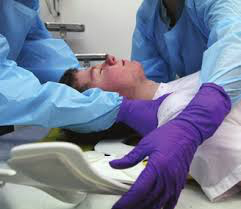Trauma Resuscitation Clinical Pathway — Emergency Department
Trauma Resuscitation Clinical Pathway — Emergency Department
Cervical Spine (C-Spine) Immobilization
Goal
Identify and immobilize patients at risk for C-spine injury
| Cervical immobilization indications after BLUNT trauma Imaging Considerations |
|
|---|---|
| Patient arrives in cervical collar (C-Collar) after BLUNT trauma |
|
| Cervical immobilization indications after PENETRATING trauma |
|
Evaluation and Clearance of Cervical Spine Immobilization Job Aid
Manual Cervical Immobilization
- C-collars remind the patient and staff that the neck should remain immobile until evaluation is completed by the team.
- Collars allow a significant amount of movement of the c-spine.
- Movement of the patient during procedures with high risk of c-spine distraction should be done with manual C-spine immobilization.
- Log-roll and patient movement:
- Clinician holds c-spine immobilization from behind the patient’s head.
- All movement is coordinated by the clinician holding c-spine immobilization.
- Intubation:
- Intubation is done with the front of the c-collar open/off and manual c-spine immobilization either from behind the patient’s head or from patient’s chest.

References
- Factors Associated with Cervical Spine Injury in Children After Blunt Trauma
- Utility of Plain Radiographs in Detecting Traumatic Injuries of the Cervical Spine in Children
- Clinical Clearance of the Cervical Spine in Blunt Trauma Patients Younger Than 3 Years: a Multi-Center Study of the American Association for the Surgery of Trauma.